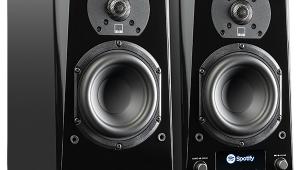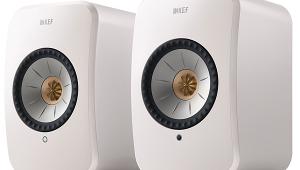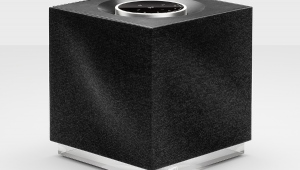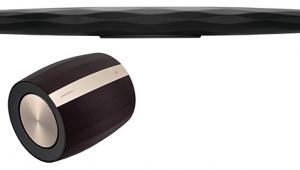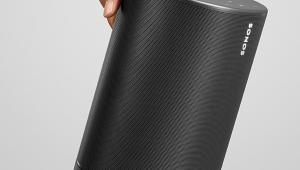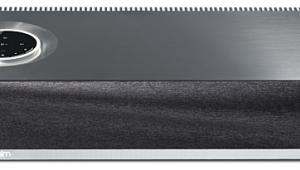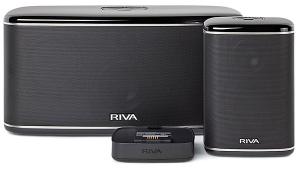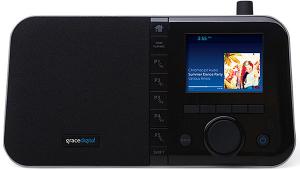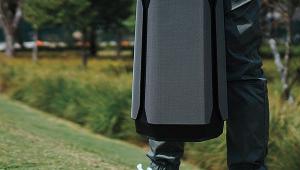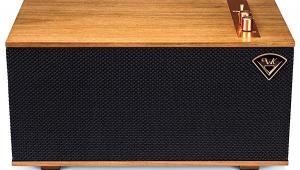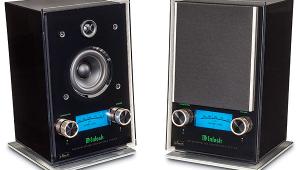McIntosh RS100 Wireless Speaker Review Page 2
Once satisfied that I had everything working right, I spent a bit of time confirming that the Play-Fi multiroom functions allowed sending the same streams to different rooms simultaneously, or different streams to different rooms. They did, though my laptop-based media server was restricted by design to one stream at a time. I also found the Play-Fi app to be a little cumbersome and glitchy. For example, it had to rescan my network to find my media server every time I first booted up the app and selected the server. And on quite a few occasions, it wouldn’t find one of the zone players on the network or one of the two speakers in my stereo pair, despite all of the devices being in the relatively near vicinity of my router; I would have to reboot the speaker and/or the app to reacquire the lost brethren. The app also hung up during the speaker-naming process when I tried to use the custom-labeling function. But I hesitate to lay the blame at this point on the Play-Fi app or ecosystem without fully understanding what Wi-Fi/network-related gremlins may somehow be at work here.
When it came time to dig in and listen, I moved into my basement studio and placed both speakers on short stands about 10 feet from my seat, at a height that put the tweeters just slightly below ear level. For the stereo pairing, the speakers were 8 feet apart and very slightly toed in; for single-unit listening, I placed the speaker directly in front of me. The RS100s were essentially in free space; the nearest boundary was 5 feet behind, probably farther away than most placements will find them. You will likely get a little more bass than what I heard with a more typical counter/desktop placement.
Show Time
I began listening to the single full-functioning speaker and found the RS100 to be characterized by surprisingly present bass (for such a small speaker), which stayed tuneful on most tracks and avoided one-note boominess. Meanwhile, the midrange favored smooth and palatable vocals and horns over any shouty exaggeration in the presence range that might have put them in greater relief. And likewise, the high end remained friendly and unfatiguing with a variety of program material, including potentially edgy tracks from lower-bit-rate streams. There were enough moments (even with the grilles off) when I wished for just a touch more detail in a brushed cymbal or the ding of a triangle, something that I know is present in my test tracks. Or perhaps a little more open air, or a bit more bite on transient edges of string plucks or horn blasts. But overall, I found the sound very well balanced and neutral across its range in the true audiophile tradition.
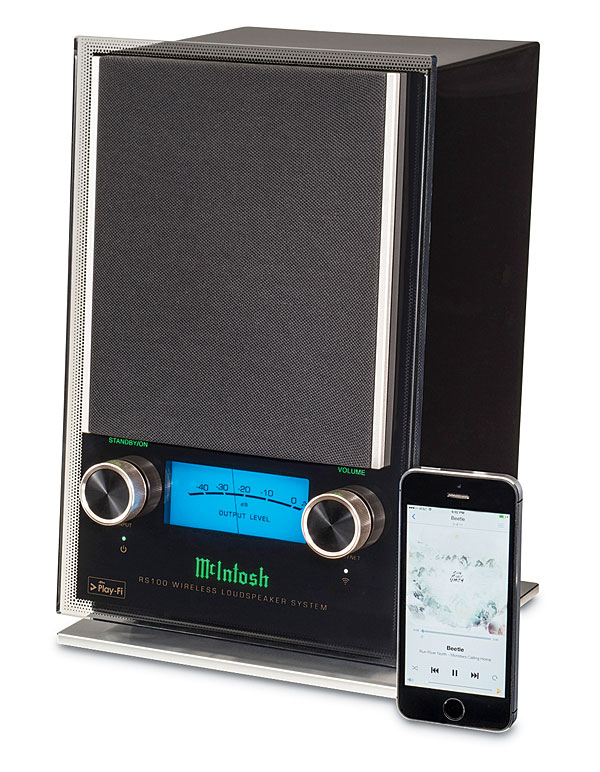
Dynamically speaking, even the single speaker working alone proved capable of reaching substantial volume in my wide-open 23 x 27 x 6.5-foot (low-ceiling!) space. It provided a good sense of build and impact when faced with a musical swell or a sharp transient. And when the speaker was pushed toward the edge of its capability, it seemed to self-limit nicely without insulting me with odd noises (port or otherwise) or obvious distortion. Beyond that point, it could be driven into unpleasantness, but only at very high volumes where I never felt the need to go.
Peter Bradley Adams’ “Be Still My Heart” (from Between Us), a CD-quality rip on my server, came through on the RS100 with clean, well-defined opening guitar notes and a solidly delivered bass underlay. Even with one speaker, Adams’ close-miked, ever-so-slightly nasal voice projected from a height well above and slightly out from the speaker, and with the full chest behind it that I expect from this track. Drum rim thwacks that enter during the chorus seemed to be set back behind the voice where they should be—again, we’re talking about a single, mono speaker here—and they were satisfyingly dynamic, even if they lacked the last word in transient snap I’d like to hear. The female backup vocal that comes in delicately behind Adams in the chorus was also well rendered and easily discernible in the busier mix.
A 44.1/16 Tidal stream of the Burt Bacharach classic “Promises, Promises,” performed by Lea Michele from the TV cast of Glee (Season 6 soundtrack), showed off what the RS100 could do with a strong female voice. The speaker handled this track’s considerable dynamic demands without breaking a sweat, and when the full horn section joins in vigorously at the vocal break a couple of minutes in, the brass came across smoothly and without unpleasant blare.
If a single RS100 sufficiently filled the room with good sound, the system took on another dimension, figuratively and literally, with two speakers mated as a stereo pair. Off my server, I started up Bruce Springsteen’s powerful live version of “American Skin (41 Shots),” his evocative and controversial comment on the New York City police shooting of immigrant Amadou Diallo in 1999. The track opens with crowd noise, and from the very first moments, I could hear that the soundstage/imaging quotient had gone through the roof, so to speak: There was a big, airy half-dome above the speakers that came down beyond their outside edges. Springsteen and various members of the E Street Band begin their solemn chants of “41 shots”—first from far left, then far right—and I got a dramatic demonstration of the value of stereo. When the crowd starts rhythmically but inappropriately clapping (Springsteen asks them for quiet), I could actually situate the claps coming from the reverberant space (or perhaps the cheap seats) behind the stage.
The Boss’s gravelly voice at center stage was big and bold and highly textured, and the Big Man’s sax, easily pinpointed at left-center stage just slightly back from Springsteen, was solid and dynamic on his solo. I suspected and quickly confirmed by going back to earlier test tracks that the stereo pair greatly improved on the single speaker’s overall midrange clarity and presence, and the system handled demanding dynamic passages with greater ease and authority, probably the result of the amp(s) not having to work as hard to achieve volume.
At this point, I caught the bug and started burning through a bunch of tracks just to hear stuff. The Shelby Lynne audiophile classic “Just a Little Lovin’ ” left my mouth hanging open: The bigger-than-life opening drum kit and guitar notes, followed by Lynne’s huge and sultry voice, were set into a seemingly boundary-less soundstage. The high-quality material from Frederick Fennell leading the Dallas Wind Symphony, courtesy of Reference Recordings, was also favored by the RS100s. The speakers beautifully delivered the flutes, woodwinds, and horns in the “At the Ballet” section of a medley from A Chorus Line, filling up the room with their collective, harmonious power. And I could go on, of course.
Conclusion
All in all, I found the RS100 to be a good-sounding and gorgeously designed piece of kit that, especially in its stereo pairing (as McIntosh says most people use it), any audiophile would proudly show off and happily live with for casual daily listening. If I can offer any caveats at all, first is the potential for operational quirks with the Play-Fi system, something that I gather is largely beyond the hands of McIntosh and other Play-Fi licensees. I say “potential,” by the way, because I accept that my experience (in my home and with my network) doesn’t necessarily have to be yours, which is one of the realities we now live with in multiroom audio.
Beyond that, there’s price: Obviously, if you’re looking for an audiophile-quality wireless speaker, there’s a lot of stellar-sounding competition at or below, maybe well below, the cost of this $1,000 speaker or the $2,000 stereo pair that I much preferred. On the other hand, if you melt at the sight of classic McIntosh gear and get warm and fuzzy thinking about the brand’s rich heritage, then there’s only one place to find all that. So, go ahead: Put your own price on it.
